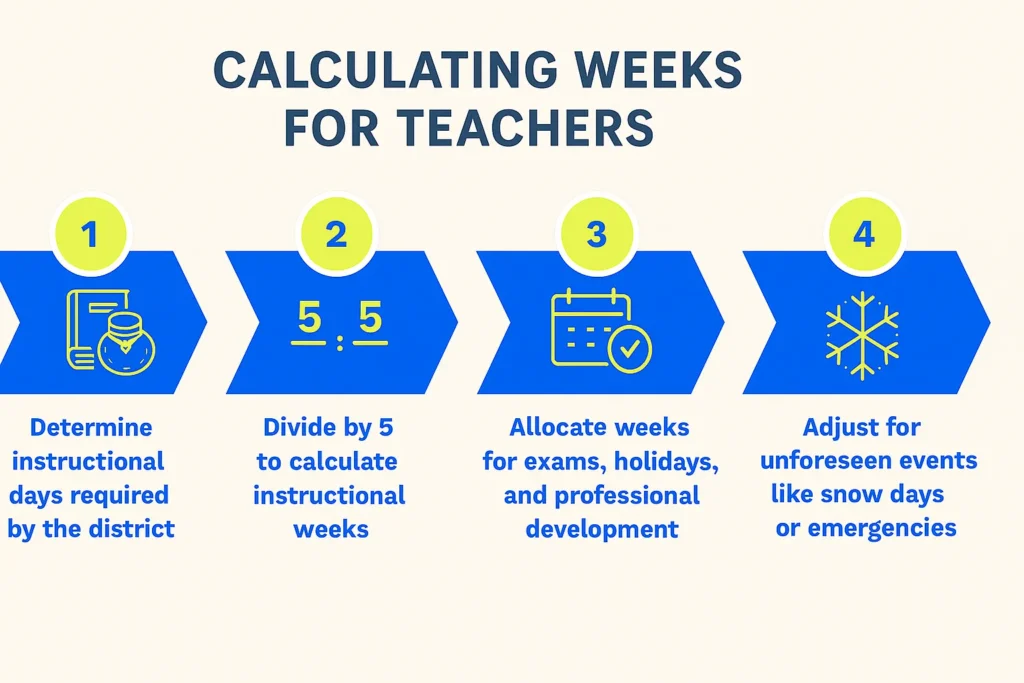
Executive Summary
The number of weeks in a school year is a key consideration for students, parents, teachers, and administrators. It impacts curriculum planning, lesson schedules, holidays, exams, and extracurricular activities. While school years typically follow a structured calendar, the exact number of weeks can vary based on country, state, education level, and institution type.
This guide provides a comprehensive overview of school year lengths, calculations for weeks, variations in global education systems, historical context, scheduling strategies, and practical applications for planning and productivity.
Table of Content
1. Understanding a School Year
1.1 Definition
A school year, also known as an academic year, is the period during which students attend classes and participate in formal education. It is divided into semesters, trimesters, or quarters, and includes instructional days, holidays, and vacation breaks.
1.2 Importance of Defining a School Year
- Curriculum Planning: Teachers allocate lessons, projects, and exams based on weeks available
- Attendance Tracking: Schools measure student engagement and attendance weekly
- Financial Planning: Tuition, payroll, and operational costs are scheduled around the academic year
- Extracurricular Planning: Sports seasons, clubs, and other programs follow weekly schedules
2. Standard Length of a School Year
2.1 Instructional Days
Most schools operate on a minimum number of instructional days rather than exact weeks. For example:
- United States: Typically 180 days per year
- United Kingdom: About 190 days per year
- Australia: Around 200 days per year, depending on state regulations
2.2 Calculating Weeks in a School Year
Since a week has 5 school days (Monday–Friday), the approximate number of weeks in a school year can be calculated as: Weeks in a school year=Instructional days5\text{Weeks in a school year} = \frac{\text{Instructional days}}{5}Weeks in a school year=5Instructional days
Examples:
- U.S.: 180 days ÷ 5 = 36 weeks
- U.K.: 190 days ÷ 5 ≈ 38 weeks
- Australia: 200 days ÷ 5 = 40 weeks
Observation: School years are typically 36–40 weeks long, excluding holidays and breaks.
Related Reads You’ll Enjoy
Want to explore more about time management, productivity, and academic planning? These articles will help you dive deeper:
- How Many Weeks Are in a Year – Learn how the total number of weeks in a year affects scheduling, holidays, and work cycles.
- What Is Time Management – Understand the strategies for organizing time effectively to boost academic and personal success.
- Why Is Time Management Important – Discover how effective time management improves performance for students and professionals alike.
- What Is Business Management – See how schools and organizations apply management principles for smoother operations.
- What Is Performance Management – Explore how managing performance ties closely to time and goal achievement.
3. Variations by Education System
3.1 United States
- Standard: 180 instructional days
- Divided into two semesters or three trimesters
- Breaks include summer vacation, winter break, and spring break
- Approximate weeks: 36 weeks
3.2 United Kingdom
- Standard: 190 days
- Divided into three terms: Autumn, Spring, Summer
- Includes half-term holidays and national holidays
- Approximate weeks: 38 weeks
3.3 Australia
- School years vary by state
- Typically 200 days, divided into four terms
- Includes holidays of 2–3 weeks between terms
- Approximate weeks: 40 weeks
3.4 Other Countries
- Canada: 180–190 days
- Germany: 38–40 weeks with longer summer holidays
- Japan: 210 days with short summer and spring breaks
Observation: The length of a school year is influenced by government regulations, cultural norms, and climate considerations.
4. Breakdown of Weeks in a School Year

4.1 Semester System
- Two main semesters: Fall and Spring
- Each semester: 16–20 weeks of instruction
- Includes exam weeks and review sessions
4.2 Trimester System
- Three terms: Fall, Winter, Spring
- Each term: 12–14 weeks
- Allows shorter, more focused instruction periods
4.3 Quarter System
- Four terms: Fall, Winter, Spring, Summer
- Each quarter: 10–12 weeks
- Common in universities and some private schools
Observation: Week counts are approximate and depend on instructional policies, holidays, and professional development days.
5. Holidays and Breaks
School calendars include holidays that reduce the number of instructional weeks:
- Summer Vacation: Typically 6–12 weeks
- Winter Break: 1–2 weeks
- Spring Break: 1 week
- Public Holidays: Vary by region and can add 1–2 weeks
Example: In a U.S. school with 180 instructional days, adding holidays may stretch the academic calendar to cover approximately 40–42 calendar weeks, even though the instructional weeks remain 36.
6. Historical Perspective
6.1 Origin of the School Year
- Early education followed agricultural cycles, with children off during harvest seasons
- Industrialization shifted to longer academic years to support structured education
- Modern school years balance instructional needs and vacation periods
6.2 Evolution of Weeks
- Originally, schools measured time in terms or months rather than weeks
- Today, weeks are the primary unit for lesson planning and scheduling exams
7. Calculating Weeks for Teachers
Teachers use weeks to plan curriculum, track progress, and schedule assessments:

- Step 1: Determine instructional days required by the district
- Step 2: Divide by 5 to calculate instructional weeks
- Step 3: Allocate weeks for exams, holidays, and professional development
- Step 4: Adjust for unforeseen events like snow days or emergencies
Example: 180 days ÷ 5 = 36 weeks. Allocate 2 weeks for midterms, 2 weeks for final exams, leaving 32 weeks for teaching.
8. Weeks for Students
Students use school weeks for learning, homework, and extracurricular activities:
- Homework Planning: Daily tasks add up to weekly workloads
- Project Deadlines: Often based on 1–2 week increments
- Extracurriculars: Clubs, sports, and arts activities follow weekly schedules
- Progress Monitoring: Teachers assess performance weekly or biweekly
9. Weeks for Parents
Parents can plan around school weeks to:
- Schedule family vacations
- Plan childcare during holidays and teacher in-service days
- Monitor student progress and attendance
10. School Year Variations by Grade Level
10.1 Elementary School
- Typically 36–38 weeks
- Shorter daily schedules but more frequent breaks
10.2 Middle and High School
- 36–40 weeks
- Includes semester or trimester exams
10.3 College and University
- Weeks vary by system:
- Semester: 15–18 weeks
- Quarter: 10–12 weeks
- Trimester: 12–14 weeks
- Summer sessions may add 4–12 weeks
11. Special Considerations

11.1 Make-Up Days
- Schools may add extra days or weeks for snow days, hurricanes, or emergencies
- This can slightly increase instructional weeks in a calendar year
11.2 Professional Development Days
- Teachers often have 1–2 weeks for training
- Students may not attend, so instructional weeks remain unaffected
11.3 Flexible Schedules
- Some schools offer year-round education, spreading 180–200 instructional days across 12 months
- Weeks per term may be shorter but more evenly distributed
12. Weeks in the Academic Calendar
A typical U.S. school calendar might look like this:
| Term | Instructional Weeks | Notes |
|---|---|---|
| Fall | 16 weeks | Includes midterm exams |
| Winter | 8 weeks | Short term before break |
| Spring | 12 weeks | Includes final exams |
| Total | 36 weeks | Standard instructional weeks |
This example aligns with 180 instructional days ÷ 5 = 36 weeks.
13. Global Comparisons
| Country | Instructional Days | Weeks per Year | Notes |
|---|---|---|---|
| USA | 180 | 36 | Includes 2-week winter break |
| UK | 190 | 38 | Divided into 3 terms |
| Australia | 200 | 40 | Four terms, includes public holidays |
| Canada | 180–190 | 36–38 | Provincial variation |
| Germany | 190–200 | 38–40 | Long summer vacation |
Observation: Weeks in a school year are similar globally, typically ranging 36–40 weeks, with adjustments for holidays.
14. Calculating Weeks for Planning
14.1 Step-by-Step Method
- Determine total instructional days
- Divide by 5 school days per week
- Subtract planned breaks
- Add make-up or professional development days if needed
14.2 Example Calculation
- Total instructional days: 180
- Breaks: 10 days (holidays)
- Net instructional days: 170
- Weeks: 170 ÷ 5 = 34 weeks
This approach helps administrators and teachers plan lesson pacing and assessments efficiently.
15. FAQs
Q1: How many weeks are in a U.S. school year?
A: Approximately 36 weeks (180 instructional days ÷ 5).
Q2: Can a school year have more than 40 weeks?
A: Rarely. Most schools have 36–40 weeks; year-round schools may distribute days differently.
Q3: Do holidays count as school weeks?
A: No, instructional weeks only include days when students attend school.
Q4: How are weeks used in curriculum planning?
A: Teachers plan lessons, assignments, and exams on a weekly basis.
Q5: Are summer school weeks counted?
A: Yes, if students attend, but they are usually separate from the main school year.
16. Conclusion
The number of weeks in a school year typically ranges from 36 to 40 weeks, depending on country, grade level, and school policies. Understanding this helps students, teachers, and parents plan effectively for academic work, exams, holidays, and extracurricular activities.
Key points:
- School years are based on instructional days rather than exact weeks
- Weeks provide a practical framework for curriculum, assessments, and scheduling
- Variations exist globally, but most systems aim for 36–40 instructional weeks
- Additional considerations include holidays, breaks, make-up days, and professional development
By mastering the concept of weeks in a school year, all stakeholders can ensure efficient time management, academic success, and well-balanced educational planning.


